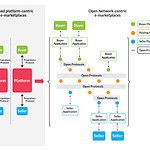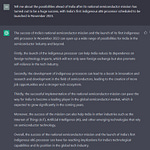Antriksh Matters: Russia’s in Cooperative Mood on Space Stations
— Aditya Pareek
Despite the ubiquity of remotely operated space vehicles, inhabited orbital stations remain a symbol of prestige and scientific endeavour. In Russia’s case, much of its spacefaring tradition is tied to its history as a pioneer of the final frontier.
Russia has continued to support the International Space Station(ISS) and has launched another module, this time a docking node called “Prichal”, the Russian word for pier. The Prichal is the second module launched and successfully integrated to the ISS by Russia this year, and according to RIA Novosti it might be the last one Russia has planned for the ISS as of now. The Prichal has five docking slots that can accommodate cargo and crew spacecraft wishing to dock to the ISS. It is also interesting that Russian state space company ROSCOSMOS, according to another RIA Novosti article, is in discussions with NASA on how SpaceX’s Crew Dragon can dock with Prichal. According to the article:
a docking interface, that is, a special adapter, would be required for American spacecraft.
ROSCOSMOS has acknowledged the revolutionary role SpaceX has played in bringing new efficiencies to spacefaring. Significantly for the Russians, SpaceX has given NASA an alternative to the Soyuz missions for sending crews and cargo to the ISS.
Only India among the BRICS can Help
While Russia has not closed the door on the ISS, it has nevertheless started pursuing its own alternative, a unilateral space station tentatively called “Russian Orbital Service Station (ROSS)”. The project was at one point envisioned to be undertaken with BRICS (Brazil, Russia, India and China) partners. However, no significant support in terms of financial commitments came through from BRICS or any other partners. Now ROSCOSMOS is moving ahead with the design of ROSS with Russian state funding.
Furthermore, China has started assembling its own unilateral space station, the “Tiangong” with its core module “Tianhe” already operational in orbit.
Brazil and South Africa do not seem to have similar financial wherewithal or short-medium term ambition on sustained human presence in orbit. That leaves only India. The country’s human spaceflight efforts are set to begin with the Gaganyaan mission which, as ISRO chairman Dr. K. Sivan recently said, is a major thrust area for international cooperation, especially with Russia. It would be interesting to see if Russia is able to persuade India to work with it on a joint space station derivative of, or integrated with, ROSS project.
According to a report in Russian business newspaper Kommersant, Russian Ambassador to India Nikolai Kudashev said India and Russia are also discussing joint production:
The ambassador also noted that in the field of space, Russia and India "are discussing not only the supply of engines, but are also talking about joint engine building, joint development of launch vehicles - heavy, light and ultralight, joint creation of satellites.”
The ambassador also indicated joint Lunar exploration is still on the Russia-India agenda, though this was yet to be discussed in detail by both countries.
If you like the content of this newsletter consider signing up for our Post-Graduate Programme in Public Policy (PGP). The course is targeted at dynamic individuals who wish to enter the growing professional sphere of policy, public affairs, governance and leadership, while pursuing their current occupations. The PGP equips participants with a core set of skills in policy evaluation, economic reasoning, effective communication and public persuasion.
Matsyanyaaya: China’s ‘Quantum Leap’ Overhyped or Genuine Threat?
— Arjun Gargeyas
(An edited version of this article first appeared in The South China Morning Post on 23rd December 2021.)
President Xi Jinping, back in 2016, established a national strategy for China to become technologically self-reliant and soon surpass the United States as the global leader in emerging and critical technologies. At the heart of this was quantum innovation and research. Apart from allocating funds for a long-term quantum mega project, President Xi also announced the establishment of a National Laboratory for Quantum Information Sciences.
An announcement made by a group of Chinese scientists in late 2021 buttresses the country’s growth in the field. They declared the creation of a quantum communication network in space using their quantum satellite to secure the national power grid against blackouts and other long-distance attacks. This is a massive leap forward in building secure communication networks using quantum science and technology. It also underlines the strides made by China in the field and the significant advantage it has gained over its competitors in the recent past.
It was in 2008 that a certain Pan Jianwei returned to China in the hope of facilitating quantum research in the country. Hailed as the ‘Father of Quantum Physics’ in China, Jianwei founded a lab at the University of Science and Technology of China (USTC) dedicated to achieving quantum breakthroughs. This ushered in a quantum revolution in the country with extensive research projects on quantum science, especially communications, taking shape. This focus on quantum communications resulted in advanced telecommunications and cryptography systems being developed by the scientific community in the country.
The Beijing-Shanghai communication line, which was opened in 2017, was a result of this decade-long quantum research. It was hailed as the world’s longest un-hackable communication line. Though not a fully realised quantum connection, the line is divided into multiple nodes (based on the distance traveled by each photon before succumbing to noise) which provided a high level of security. China also launched the world’s first quantum satellite in 2016 that was pushed to a higher orbit for a wider coverage to develop the quantum internet. The satellite programme was started in the hope of securing communications between military outposts, embassies, government bodies, and financial institutions. These advancements have effectively made China the global leader in quantum communications.
In terms of quantum computing and its applications, China was behind the United States in both investments and technological superiority until this year. The revealing of Zuchongzhi, a Chinese-made quantum computer comprising of superconducting 66 qubits easily surpasses the speed and computing power of Google’s quantum computer, Sycamore. There was also a major improvement to their photonic quantum computer raising the number of qubits from 76 to 113. Owning two of the fastest computers in the world, China now is the only country to achieve a quantum advantage in both photonic and superconducting quantum computing.
With China pulling ahead in the quantum race, there are also threats of the Chinese government exploiting and weaponising critical quantum technologies for military purposes. This would mean that the Chinese military might develop capabilities to neutralise many offensive and defensive military technologies of its rivals. A Chinese company, Electronic Technology Group Corporation, has claimed having developed Quantum Radar which is supposedly capable of determining the type of airplane and the weapons the airplane is carrying. This would render any stealth technology useless. The Chinese National Academy of Science has reported the development of a quantum submarine detector using extremely sensitive sensors called SQUIDs (Superconducting Quantum Interference Devices). This has the ability to detect a submarine from a long distance away creating limitations for all opposing forces. If these technologies are functional as the Chinese claim, the possibility of China gaining a military quantum advantage is imminent.
China has definitely made incredible progress in building its quantum ecosystem. With quantum research driven by the state and concentrated in a few university research labs, the funding provided by the Chinese government consistently remains on the higher side. This has resulted in critical breakthroughs in the domain. However, inherent challenges remain for China to navigate before officially winning the quantum race.
CyberPolitik #1: DCNs Reporting for National Security Duty
— Prateek Waghre
In August 2021, the actions that the likes of Facebook, Twitter were about to take (or not take / or had not taken in the months/year before it) in the aftermath of the Taliban’s takeover of Afghanistan were the subject of intense scrutiny and debate. These were yet another reminder of how entangled DCN firms are in decisions that have significant geopolitical implications as well as the national security of individual states.
Literature on the role of DCNs primarily invokes the lenses of competition, privacy and speech. However, a recent paper, ‘National Security by Platform’ by Elena Chachko, proposes a framework for analysing their role in the privatisation of national security functions.
Before going into the framework, there are some key points the paper makes which are worth considering upfront. I’ve paraphrased my interpretation here:
Ad hoc developments: The growing role of DCN firms in geopolitics and national security weren’t the product of a deliberate, consensus-building exercise. Instead, these were ad hoc, piecemeal and incremental steps in response to significant events such as terrorist attacks, concerns over election integrity, etc.
Contradiction with Competition: While competitive markets envisage many private firms taking part, a market with a limited set of large-scale operators is better suited for cooperation with the national security apparatus and rapid, uniform responses/actions.
DCN capabilities and intent: Are DCN firms capable of meeting national security challenges, and are they likely to prioritise addressing them over profits?
Chachko makes the following points about the relationships between DCN firms and governments (I’ve separated them into bullet points for better readability) :
… Involve threat analysis and policy development cooperation, information sharing, and platforms replicating government practices and methods.
A mutually beneficial, at times even symbiotic, relationship has emerged between platforms and government agencies in addressing certain important national security and geopolitical challenges.
On other fronts, however, platforms and government have clashed.
These trends can be considered to be forms of ‘indirect, informal national security privatization’, and proposed the following categories:
A. Hard Structural Constraints
There can be institutional or constitutional limitations/constraints on state actors. For example, state actors likely have neither the capability to detect/respond to sophisticated disinformation operations nor the authority to control what information can or cannot be posted/shared in other jurisdictions. DCN firms, on the other hand, exercise more control over these spaces (at least the ones they operate) and have the tools/capabilities/expertise to understand these threats better than state actors. This creates a need for state actors to rely on private actors.
B. Bureaucratic Workarounds
Even in the absence of ‘hard constraints,’ state actors may choose to rely on / cooperate with DCN firms to work around legal/administrative requirements and/or political opposition, speed up response times, limit the visibility of their role, etc.
Both categories A and B require varying degrees of cooperation between state actors and DCN firms. They are also not mutually exclusive.
C. Platforms as Substitutes
In cases of inaction by state actors, or when their desired/preferred actions are at odds with government policy prescriptions/direction, DCN firms may resort to acting unilaterally, essentially substituting for state actors.
And while privatisation in the context of national security, both formal and informal, are not unique to platforms, Chachko argues that it is the change in scope that is significant:
The breadth of security and geopolitical policy and execution discretion that platforms currently exercise is striking. Questions such as what to do about genocide in Myanmar, what kinds of coordinated behavior constitute security threats and require enforcement, what foreign government blowback might ensue following such enforcement, what is necessary to secure the Indian election and protect its integrity, how to respond to Turkish demands to silence opposition,or what constitutes credible information about COVID-19 are complex and open-ended. They require far broader and more diverse expertise and greater exercise of policy discretion than identifying individual terrorism suspects or monitoring violent groups, finding breaches of computer systems, exposing zero-day vulnerabilities, or even attributing computer breaches to perpetrators.
CyberPolitik #2: Consider the benefits of Digital Communication Networks
— Sapni G K
This entry is adapted from one of the sections of a forthcoming discussion document by Prateek Waghre and Sapni G K on the opportunities and benefits associated with Digital Communication Networks.
As Prateek had written in the previous issue of this Newsletter, the discourse around Digital Communication Networks (DCN) tends to be dominated by the harms they have caused. Literature around DCNs focuses heavily on the myriad of troubles they have exacerbated with little consideration of their benefits, particularly from the Indian perspective. In our latest discussion document, we attempt to examine the potential opportunities and benefits that could be attributed to DCNs. We broadly look at how DCNs interact with the market and the society at large. In this section, I will write about the interaction between DCNS and the market, which has contributed to the creation of new economic opportunities and efficiencies.
DCNs have facilitated the growth of business models that were thought to be highly improbable or previously associated with high transaction costs. This includes the booming creator economy with its turbocharged growth during the pandemic. They even enabled new job categories such as social media managers and curators, which did not exist in the world before DCNs. They also help many people to reach out to their extended networks for job opportunities, which has facilitated the freelance economy. Since DCNs transcended geographies and economic divides, a range of new opportunities was created and amplified. This benefitted Indian businesses in multiple ways. Their operations were globalised, with small and medium enterprises also eyeing the global market. Analytics and visualisation tools that are a part of most DCNs helped firms understand trends in real-time and modify their business practices. DCNs also facilitated the opening up of entirely new markets, such as the thrifting- used clothes retail, that has historically been looked down upon. The advertisement model that DCNs presented helped businesses to move into targeted marketing. Many DCNs operate on the advertisement-supported business model where they provide access to their services in return for tracking users’ activities, both on and off the platforms, and serving them targeted advertisements.
Calculating the economic efficiency of different domains is an inherently difficult task. At the level of algorithm design, calculations have historically considered informativeness as the near equivalent of economic efficiency. Through the document, we identify increased informativeness and online social graphs as tools for creating economic efficiency, which has led to the compounding of benefits created by DCNs.
While the points mentioned above only represent a small portion of our document, they serve the purpose of reiterating why it is important to reorient our perspectives on conversations about the governance of DCNs. We argue that these cumulative benefits should not be lost out as proposals for governance and regulation are presented across the globe. India, in particular, has benefitted immensely from DCNs, and caution must be exercised when we think of regulating them.
You can read the entire document here. This is a work in progress, as part of our investigations into the ecosystem of DCNs. If you have thoughts/comments on the same, do reach out via Twitter DMs (@SapniGK) or email me (<FirstName> AT takshashila.org.in ).
Our Reading Menu
[Chapter]Approaching the Third Rail? A Trilateral Treaty to Prohibit Space-Based Missile Defenses
[Report] Getting the multidomain challenge right
[Paper] State policy against information war by Dmitry Shibaev and Nina Uibo
[Paper] The role of internet media in informational counteracting between Ukraine and Russiaduring the war in the East by Nadia Herasymchuk and Anatolii Yakovets









